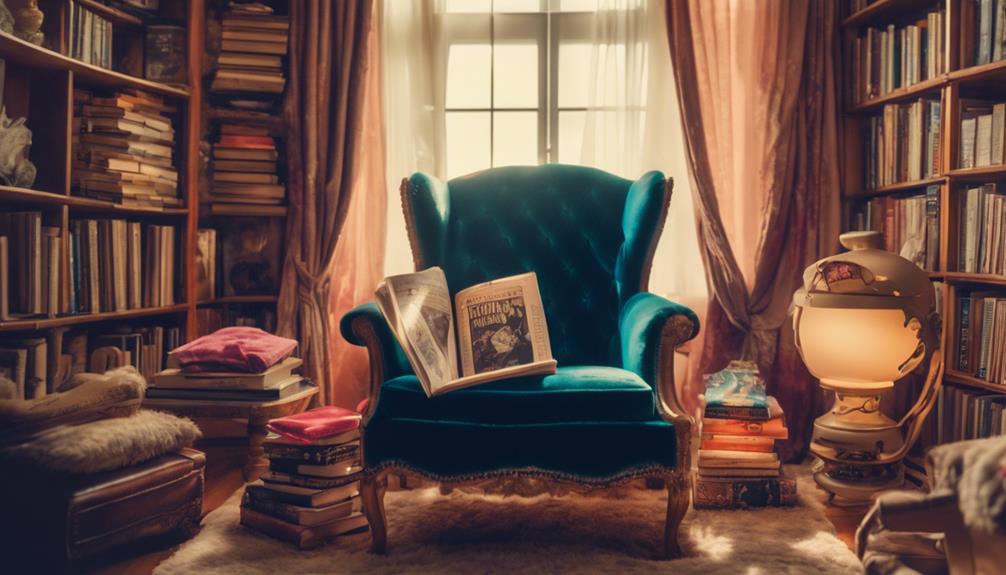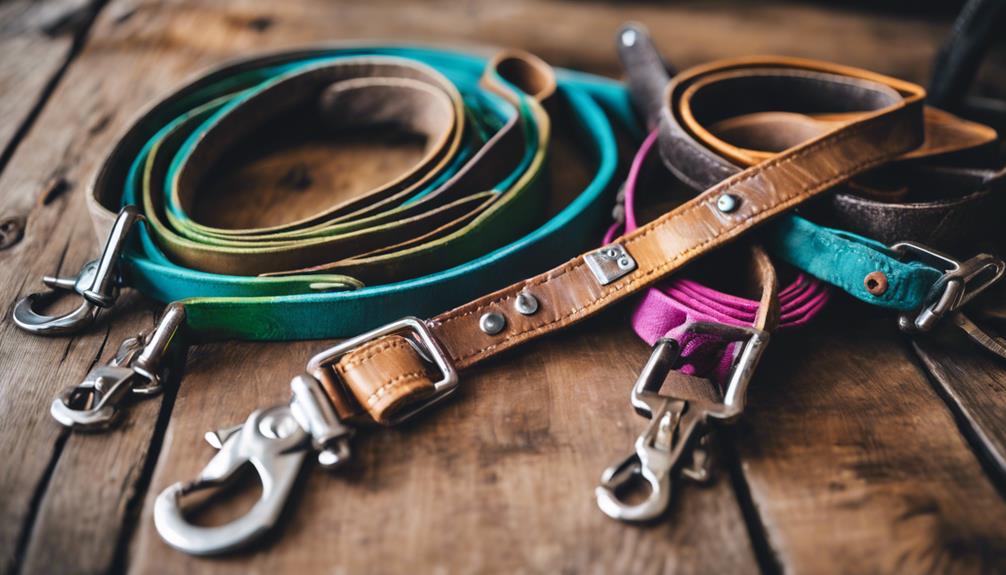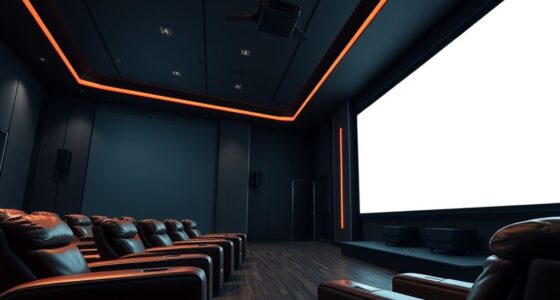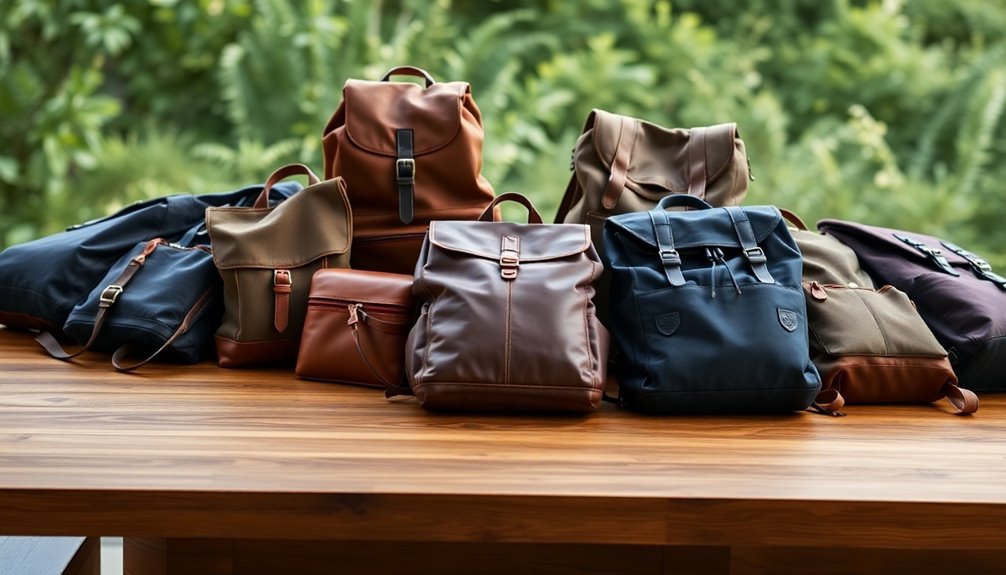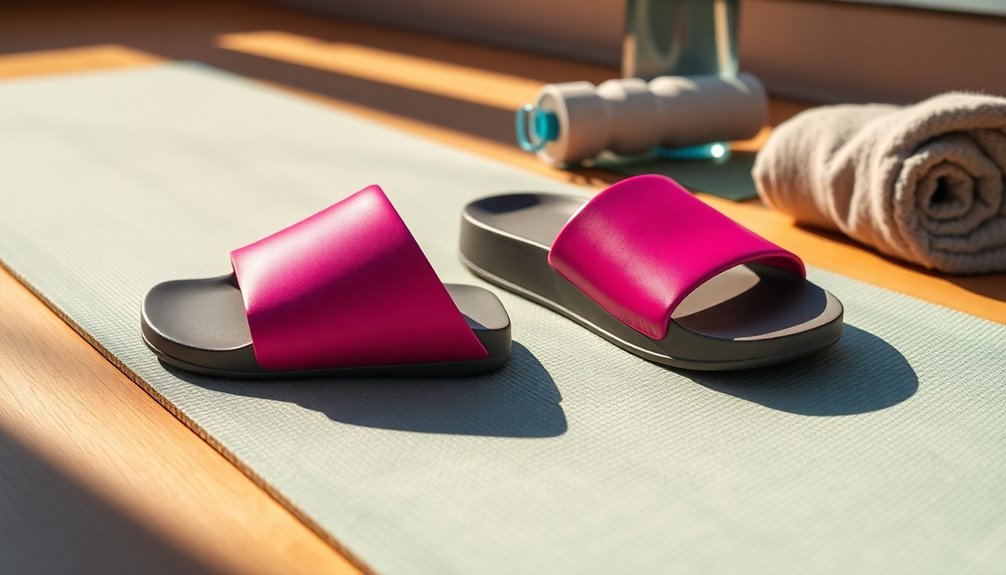I have discovered 14 essential fashion books that showcase the art of pochoir, highlighting its intricate role in illustrating fashion history. Titles such as “Fashion and the Art of Pochoir” and “French Art Deco Fashions in Pochoir Prints” offer insights into the technique’s vibrant illustrations and stylish evolution. These books feature works by influential artists like Paul Iribe and George Barbier, showcasing exquisite designs from the 1910s and 1920s. These resources provide both visual appeal and historical context, making them valuable for fashion enthusiasts. If you are interested in specific recommendations and their unique contributions, there is plenty more to explore.
Key Takeaways
- Fashion and the Art of Pochoir features 300 illustrations showcasing the vibrant pochoir technique essential for understanding early 20th-century fashion and art.
- French Art Deco Fashions in Pochoir Prints from the 1920s offers an extensive collection of haute couture designs, reflecting the originality of the Art Deco era.
- Art Deco Fashion Illustrations: Pochoir Prints explores various aspects of fashion from 1908 to 1927, appealing to enthusiasts of visual art and fashion history.
- French Fashions of Good Taste 1920-1922 presents innovative silhouettes and geometric patterns through pochoir illustrations, serving as a primarily visual resource.
Fashion and the Art of Pochoir: The Golden Age of Illustration in Paris

For anyone captivated by vintage fashion and the artistry of illustration, 'Fashion and the Art of Pochoir' is a must-have treasure that beautifully encapsulates the glamour of early 20th-century Paris.
This book showcases 300 exceptional illustrations from luxury fashion publications, presented on thick, high-quality paper. It highlights the pochoir technique, where layers of gouache paint or watercolor create vibrant colors that truly stand out.
Renowned artists like Paul Iribe and Georges Lepape are featured, showcasing their work alongside designers such as Paul Poiret and Jeanne Lanvin.
The book not only provides stunning visuals but also includes biographical descriptions, giving context to the artistry.
Overall, it's an essential read for anyone interested in the intersection of fashion and art during this golden age.
Best For: Vintage fashion enthusiasts and art lovers who appreciate the intersection of fashion illustration and historical context.
Pros:
- Stunning Visuals: The book features 300 exceptional illustrations, making it a visual delight.
- Cultural Insight: It provides biographical descriptions that enrich the understanding of the fashion and art of the era.
Cons:
- Niche Interest: May not appeal to those outside the vintage fashion or art communities.
- Price Point: As a luxury item, it may be considered expensive for casual readers.
French Art Deco Fashions in Pochoir Prints from the 1920s

Fashion enthusiasts and designers alike will find 'French Art Deco Fashions in Pochoir Prints from the 1920s' an invaluable resource, brimming with exquisite illustrations that capture the essence of this iconic era.
This extensive book showcases a vast collection of fashion plates from 1924 to 1931, illustrating the revolutionary designs that defined haute couture.
It features the work of notable designers such as Charles Worth and Paul Poiret, highlighting their significant contributions to the Art Deco movement.
The delicate pochoir prints, known for their fine details and originality, stand as masterpieces in their own right.
This book serves not only as a historical reference but also as a source of inspiration for contemporary fashion work, making it essential for any style enthusiast.
Best For: Fashion enthusiasts, designers, and historians seeking inspiration and historical context from the Art Deco era.
Pros:
- Rich Collection: Features a vast array of exquisite pochoir prints that beautifully capture 1920s fashion.
- Designer Insights: Highlights contributions from renowned designers, providing valuable context for fashion evolution.
Cons:
- Limited Timeframe: Focuses solely on the years 1924 to 1931, which may not appeal to those interested in other eras.
- Niche Audience: Primarily targeted at enthusiasts of fashion history, potentially limiting its broader appeal.
Art Deco Fashion Illustrations: Pochoir Prints

Art Deco enthusiasts will find 'Art Deco Fashion Illustrations: Pochoir Prints' an invaluable resource, showcasing exquisite graphics that capture the era's elegance and artistic innovation.
This book presents a rich collection of illustrations from 1908 to 1927, highlighting the essence of Art Deco fashion. Using high-quality pochoir printing techniques, the prints are often limited editions, making them rare and collectible.
Each chapter explores different aspects of Art Deco fashion, discussing original artists, media, and styles. The historical context enhances the reader's understanding, reflecting the cultural shifts following World War I.
Overall, this book is praised for its visual appeal and informative content, making it a must-have for fashion history enthusiasts and art collectors alike.
Best For: Art Deco enthusiasts, fashion history aficionados, and art collectors seeking a visually stunning resource on early 20th-century fashion illustrations.
Pros:
- High-quality pochoir prints that offer intricate details and vibrant colors, showcasing the craftsmanship of the Art Deco era.
- Informative chapters that explore various aspects of Art Deco fashion, providing context and enhancing understanding of the cultural significance.
Cons:
- Some illustrations may not appeal to every reader's taste, potentially limiting its audience.
- The focus on specific historical context may not attract those looking for broader fashion trends beyond the Art Deco period.
French Fashions of Good Taste 1920-1922 Book

This stunning collection of pochoir illustrations from 'French Fashions of Good Taste 1920-1922' is perfect for anyone captivated by the vibrant elegance of Art Deco style.
Featuring original prints from the renowned Gazette du Bon Ton, the book showcases exceptional works by artists like George Barbier and Pierre Brissaud. Their illustrations highlight the innovative silhouettes and geometric patterns that defined 1920s fashion.
While the visuals are breathtaking, some critiques mention the book's glossy pages and lack of detailed text. It serves primarily as a visual resource for fashion designers and collectors.
Despite its mixed reviews, the artistic quality remains a strong draw for those fascinated by the evolution of 1920s fashion.
Best For: This book is best for fashion designers, collectors, and artists seeking visual inspiration from the 1920s Art Deco era.
Pros:
- Exceptional pochoir illustrations by renowned artists like George Barbier and Pierre Brissaud.
- Captures the innovative silhouettes and geometric patterns that defined 1920s fashion.
Cons:
- Glossy pages may detract from the overall quality of the book.
- Lacks detailed informative text, limiting its depth as a reference.
French Fashion Pierre Brissaud Pochoir Poster Print (18 x 24)

For anyone looking to elevate their home decor with a touch of vintage elegance, the French Fashion Pierre Brissaud Pochoir Poster Print (18 x 24) stands out with its vibrant colors and intricate details.
This licensed reproduction captures the essence of the original 1914 artwork, showcasing its artistic flair on premium heavy stock paper.
At 18 by 24 inches, it's the perfect size for framing or hanging directly on your wall, making it a versatile addition to any room.
Weighing only 1 pound, it's easy to manage during installation.
The print is packaged thoughtfully, ensuring it arrives in pristine condition.
With a manufacturer's warranty available, it's a reliable choice for art enthusiasts seeking quality and style.
Best For: Art enthusiasts and vintage decor lovers looking to enhance their living spaces with a stylish and colorful print.
Pros:
- Licensed reproduction ensures authenticity and quality.
- Vibrant colors and intricate details capture the essence of the original artwork.
Cons:
- Limited size options as it only comes in 18 x 24 inches.
- Potentially higher cost compared to non-licensed reproductions.
French Fashion Pierre Brissaud Pochoir Poster Print (24 x 36)

With its striking 24 x 36 size, the French Fashion Pierre Brissaud Pochoir Poster Print makes a stunning addition for anyone looking to elevate their home or office decor with a touch of vintage elegance.
This licensed reproduction of Brissaud's original 1914 artwork captures vibrant colors and intricate details, printed on premium heavy stock paper for lasting quality.
Weighing just 1 pound, it's easy to hang or frame, making it a versatile choice for any space.
The poster's dimensions guarantee it stands out, drawing attention without overwhelming the room.
Whether you're a fashion aficionado or simply appreciate fine art, this print is a worthwhile investment that beautifully showcases the art of pochoir while enhancing your decor.
Best For: Those seeking to enhance their home or office decor with a stylish and vintage-inspired art piece.
Pros:
- Vibrant Colors: The print captures vivid colors and intricate details, making it visually striking.
- Easy to Display: Lightweight design allows for simple hanging or framing.
Cons:
- Limited Size: The 24 x 36 dimensions may not fit in smaller spaces.
- Reproduction: As a licensed reproduction, it may lack the authenticity of an original piece.
French Fashion George Barbier Pochoir 1924 Poster Print

The vibrant colors and intricate details of the French Fashion George Barbier Pochoir 1924 Poster Print make it an exquisite choice for art enthusiasts and fashion aficionados alike, enhancing any space with a touch of elegance.
Measuring 18 x 24 inches, this poster print captures the vivid essence of Barbier's original artwork, printed on premium heavy stock paper.
I appreciate that it comes ready for hanging or framing, making it a hassle-free addition to my decor.
Weighing just one pound, it's lightweight and easy to handle.
Manufactured in the United States, this print stands out not only for its artistic quality but also for its competitive pricing options, allowing buyers to report lower prices if desired.
Best For: Art enthusiasts and fashion aficionados looking to enhance their decor with a touch of elegance.
Pros:
- Vivid colors and intricate details that capture the essence of the original artwork.
- Printed on premium heavy stock paper, ensuring quality and durability.
Cons:
- Limited to one size (18 x 24 inches), which may not fit all spaces.
- No framing included, requiring additional purchase for a complete presentation.
French Fashion George Barbier Pochoir Poster Print (24 x 18)

Capturing the essence of 1920s French fashion, the George Barbier Pochoir Poster Print is perfect for anyone looking to infuse their space with artistic flair and historical elegance.
This licensed reproduction of Barbier's 1924 artwork showcases vivid colors and intricate details, making it an impressive addition to any collection.
Measuring 24 x 18 inches, it's printed on premium heavy stock paper, ensuring durability and quality. Weighing just one pound, this print is easy to handle and suitable for framing or direct hanging.
The minimal thickness of 0.02 inches allows it to fit seamlessly into various decor styles. Plus, it comes with a manufacturer's warranty, giving you peace of mind about your purchase.
Best For: Art enthusiasts and home decorators seeking a stylish representation of 1920s French fashion.
Pros:
- Licensed reproduction of a renowned artist's work, ensuring authenticity.
- Vivid colors and intricate details that enhance any room's aesthetic.
Cons:
- Limited to a single design, which may not appeal to all tastes.
- Requires framing for optimal presentation, adding to overall cost.
Womens Fashion George Barbier Pochoir Poster Print (18 x 24)

For fashion enthusiasts seeking a striking visual statement, the Womens Fashion George Barbier Pochoir Poster Print (18 x 24) beautifully showcases the elegance of 1921 design.
This licensed reproduction captures the vivid colors and intricate details of Barbier's original artwork, making it a stylish addition to any space.
Crafted from premium heavy stock paper, it's not just visually appealing but also durable. Its dimensions make it perfect for framing or hanging as a standalone piece.
Weighing only a pound, it's easy to handle and display. Additionally, the manufacturer offers a warranty upon request, ensuring quality and customer satisfaction.
If you're looking to elevate your decor with a touch of historical fashion art, this poster print is an excellent choice.
Best For: Fashion enthusiasts and art collectors looking for a stylish and historical decor piece.
Pros:
- Licensed reproduction ensures authenticity and quality of artwork.
- Vivid colors and intricate details make it a striking visual statement.
Cons:
- Limited size (18 x 24 inches) may not suit larger wall spaces.
- Framing not included, requiring additional cost and effort for display.
French Fashion George Barbier Pochoir Poster Print (18 x 24)

Perfect for fashion enthusiasts and art collectors alike, the French Fashion George Barbier Pochoir Poster Print showcases stunning colors and intricate details that bring 1920s style to life.
Measuring 18 x 24 inches, this licensed reproduction is printed on premium heavy stock paper, ensuring durability and vibrancy. The vivid colors and precise details capture the essence of Barbier's original artwork, making it a striking addition to any space.
It's ready for hanging or framing, allowing for easy integration into your home or office decor. Weighing just one pound, it's lightweight yet visually impactful.
This print not only enhances your interior design but also serves as a conversation starter, connecting art and fashion history seamlessly.
Best For: Fashion enthusiasts and art collectors looking to add a touch of 1920s elegance to their decor.
Pros:
- Vivid colors and intricate details that capture the essence of the original artwork.
- Ready for hanging or framing, making it easy to integrate into any space.
Cons:
- Limited to a specific style, which may not appeal to all decor tastes.
- Requires framing for optimal presentation, adding to the overall cost.
French Fashion George Barbier Pochoir 1924 Poster Print

The stunning French Fashion George Barbier Pochoir 1924 Poster Print, with its vivid colors and intricate details, stands out as an exceptional piece for art enthusiasts and fashion aficionados alike.
Measuring 36 x 24 inches, this licensed reproduction is printed on premium heavy stock paper, ensuring durability and a striking appearance.
Weighing just one pound, it's easy to hang or frame, making it a versatile addition to any home or office decor.
The print captures the essence of Barbier's original artwork, showcasing the elegance of early 20th-century fashion.
Plus, the manufacturer's warranty is available upon request, providing added peace of mind.
This poster isn't only visually appealing but also a worthwhile investment for those who appreciate fine art.
Best For: Art enthusiasts and fashion aficionados looking to enhance their decor with a piece of early 20th-century elegance.
Pros:
- Vivid colors and intricate details that capture the essence of the original artwork.
- Ready for hanging or framing, making it a convenient addition to any space.
Cons:
- Limited to one design, which may not appeal to all tastes.
- Large dimensions (36 x 24 inches) may not fit in smaller spaces.
French Fashion George Barbier Pochoir Poster Print (24 x 36)

Capturing the essence of 1920s French fashion, the George Barbier Pochoir Poster Print is a stunning addition for anyone wanting to elevate their home or office decor with vibrant artistic flair.
Measuring 24 x 36 inches, this licensed reproduction is printed on premium heavy stock paper, ensuring vivid colors and intricate details reflect the original artwork beautifully.
Weighing just one pound, it's easy to handle and ready for hanging or framing.
The print's design makes it an ideal choice for those who appreciate art and fashion history.
Plus, it comes with a manufacturer's warranty available upon request, adding an extra layer of assurance for buyers.
Overall, it's a fascinating piece that seamlessly blends style and sophistication into any space.
Best For: Those who appreciate 1920s French fashion and want to enhance their home or office decor with a touch of artistic elegance.
Pros:
- Licensed reproduction that captures the vivid colors and details of the original artwork.
- Ready for hanging or framing, making it easy to display in any setting.
Cons:
- Limited to a specific era and style, which may not appeal to all tastes.
- Requires wall space for display, which may be a limitation in smaller areas.
French Fashion George Barbier Pochoir Poster Print (24 x 36)

For enthusiasts of vintage fashion art, the French Fashion George Barbier Pochoir Poster Print offers a stunning glimpse into the elegance of 1920s design.
Measuring 24 x 36 inches, this licensed reproduction captures vivid colors and intricate details, showcasing Barbier's mastery of the pochoir technique. Printed on premium heavy stock paper, it's durable and ready for display—whether you choose to hang it as is or frame it for added sophistication.
Weighing only one pound, it's easy to handle and position in your home or office. Additionally, the manufacturer provides a warranty upon request, ensuring quality assurance.
This poster print not only enhances your space but also serves as a beautiful homage to the artistry of French fashion history.
Best For: Vintage fashion art enthusiasts and collectors looking to enhance their home or office decor with a touch of 1920s elegance.
Pros:
- Licensed reproduction: Ensures authenticity and quality in the artwork.
- Vivid colors and details: Captures the intricate design and beauty of Barbier's original work.
Cons:
- Limited size options: Available only in 24 x 36 inches, which may not fit all spaces.
- No frame included: Requires additional purchase for framing if desired.
Womens Fashion George Barbier Pochoir 1921 Poster Print

With its stunning reproduction of George Barbier's 1921 artwork, this Womens Fashion poster print is perfect for anyone looking to elevate their home decor with a touch of vintage elegance.
Measuring 24 by 36 inches, it's printed on premium heavy stock paper that guarantees durability and vibrant colors. I appreciate how it captures the intricate details of the original work, making it suitable for hanging or framing.
Weighing only a pound and with a thickness of 0.02 inches, it's easy to handle and display. The print comes packaged securely, measuring 30 by 2 by 2 inches.
Plus, the manufacturer offers customer support and a warranty if necessary, enhancing my confidence in this purchase.
Best For: This poster print is best for art enthusiasts and home decorators seeking a vintage-inspired piece to enhance their living space.
Pros:
- Captures vivid colors and intricate details of the original artwork.
- Printed on premium heavy stock paper for durability.
Cons:
- Limited to a specific artistic style that may not appeal to everyone.
- Requires framing for optimal presentation, which adds to the overall cost.
Factors to Consider When Choosing Fashion and the Art of Pochoir

When I'm choosing fashion books on pochoir, I consider several key factors.
The aesthetic appeal and quality of the artwork play a significant role, along with the historical context that gives depth to the pieces.
I also pay attention to the featured artists and designers, the significance of the pochoir technique, and the target audience to guarantee the book resonates with my interests.
Aesthetic Appeal and Quality
The vibrant colors and meticulous craftsmanship of pochoir illustrations immediately draw me in, showcasing the unique artistry that defines this enchanting medium. When choosing a book on pochoir, I consider the aesthetic appeal and quality of the illustrations. The bold, saturated colors achieved through hand-stenciling techniques create a visual feast that captivates me. High-quality printing on thick paper enhances the vibrancy and detail, making the images truly pop.
I also appreciate the careful curation of illustrations from luxury fashion publications of the early 20th century. These selections highlight the elegance and creativity of that era, appealing to vintage fashion enthusiasts like myself. Additionally, many pochoir illustrations showcase intricate designs and innovative silhouettes from renowned fashion designers, reflecting the artistic alliance between fashion and visual arts.
The overall visual richness and craftsmanship in these prints serve as a valuable source of inspiration. For contemporary fashion designers and artists, these books not only provide aesthetic pleasure but also practical ideas that can be applied to modern design. In my opinion, the quality of the illustrations is essential in elevating the entire experience of engaging with pochoir art.
Historical Context Importance
Understanding the historical context of pochoir illustrations deepens my appreciation for the artistry and significance behind each piece, revealing how they reflect the societal changes of their time. The pochoir technique thrived in the early 20th century, particularly after World War I, marking a shift toward modernism and artistic expression in Europe. Illustrations from the 1910s and 1920s vividly capture the cultural zeitgeist, showcasing evolving attitudes toward fashion and femininity.
This period was characterized by a collaborative spirit between artists and fashion designers, emphasizing the interconnectedness of art and fashion. Such collaborations influenced contemporary design practices and underscored how fashion illustrations documented the changing landscape of society.
Moreover, understanding pochoir in its historical context allows me to see the evolution of fashion trends and artistic movements, highlighting its significance in fashion history. The cultural importance of pochoir prints lies in their ability to celebrate the innovative spirit of the Art Deco movement, which continues to inspire designers today.
Featured Artists and Designers
Exploring the featured artists and designers in pochoir art reveals the distinctive styles and innovative approaches that shaped the fashion illustration landscape of the early 20th century.
In the book 'Fashion and the Art of Pochoir', I encounter exceptional illustrations by notable figures like Paul Iribe, Georges Lepape, and George Barbier. Each artist's unique vision contributes to a vibrant depiction of fashion during this era.
The book highlights the work of groundbreaking designers such as Paul Poiret, Jeanne Lanvin, and Madeleine Vionnet, showcasing their significant contributions to the fashion industry. These artists employed the pochoir technique, which involved hand-stenciling with layers of gouache or watercolor, creating bold illustrations that defined luxury fashion publications.
Additionally, the biographical descriptions provided in the book offer valuable context about the featured illustrators and designers, allowing me to understand their influence and the cultural milieu of the 1910s and 1920s.
This exploration not only enriches my appreciation for pochoir art but also highlights its importance in documenting the evolution of fashion illustration. Each page reflects the artistic value and cultural significance that these artists achieved in their time.
Pochoir Technique Significance
How does the pochoir technique elevate fashion illustrations, making them not just images but artistic statements? This unique method, originating from France, employs stencils to layer colors with gouache or watercolor, resulting in vibrant and saturated illustrations that capture the eye. Used mainly in luxury fashion magazines during the early 20th century, especially the 1910s and 1920s, pochoir illustrations enhanced the artistic appeal of fashion.
One significant factor to reflect on is the craftsmanship involved; each illustration is hand-created, ensuring fine details and a distinct quality that mass-produced prints can't replicate. This uniqueness lends elegance and sophistication to fashion designs, particularly from the Art Deco era, making pochoir an essential part of fashion illustration history.
Moreover, pochoir illustrations are often regarded as masterpieces, merging fashion and art seamlessly. They continue to inspire contemporary fashion designers and artists today, highlighting their ongoing relevance.
When choosing fashion books that explore this technique, it's important to appreciate not just the visual appeal but also the historical significance and artistic depth that pochoir brings to the world of fashion illustration.
Target Audience Considerations
When selecting a book on the art of pochoir, it's essential to reflect on who'll appreciate its unique blend of fashion and artistry. The primary audience consists of vintage fashion enthusiasts and art collectors who value the historical significance of fashion illustration from the early 20th century. These readers will likely be captivated by the stunning hand-stenciled pochoir illustrations, especially due to their vibrant colors and high-quality reproductions.
Additionally, fashion designers and students studying fashion history might find the curated selection of 300 exceptional illustrations particularly inspiring for their contemporary design projects. They'll appreciate the insights into past trends and techniques that can inform modern aesthetics.
Furthermore, the book offers detailed biographical descriptions of featured illustrators and designers, appealing to those seeking a deeper understanding of the interplay between fashion and art during the golden age of illustration.
Illustrative Content Variety
Selecting a book on pochoir involves considering the variety of illustrative content that enhances the appreciation of fashion history and artistry. A well-curated selection, like in 'Fashion and the Art of Pochoir,' showcases exceptional illustrations from luxury fashion publications of the early 20th century. The pochoir technique, known for its hand-stenciled layers of gouache or watercolor, produces bold colors that truly elevate fashion illustrations.
When I look for books on this subject, I pay special attention to the artists featured. Notable figures like Paul Iribe, Georges Lepape, and George Barbier are essential, as their stylized depictions of designers reflect a significant period in fashion history. Each illustration tells a story, capturing the elegance and creativity of the golden age of fashion illustration.
Additionally, I appreciate books that provide context, such as biographical descriptions of the artists and designers. This background enriches my understanding of the artistic movements of the time.
Cultural Relevance and Impact
Understanding the cultural relevance and impact of pochoir is fundamental for appreciating its role in the evolution of fashion illustration and its reflection of societal changes in the early 20th century. This technique flourished in Paris during a transformative period, merging fashion and art. The illustrations found in 'Fashion and the Art of Pochoir' capture the elegance and creativity of that golden age, showcasing influential artists like Paul Iribe and Georges Lepape.
The book also documents the work of pioneering fashion designers such as Paul Poiret and Jeanne Lanvin, whose innovative styles reshaped modern women's fashion. Their contributions were essential in breaking traditional norms, allowing for greater expressions of femininity and sophistication in a post-World War I society. By preserving these vibrant pochoir prints, the book emphasizes the cultural significance of fashion illustration as a medium.
Additionally, the historical context provided serves as an important resource for understanding the lasting impact of the Art Deco movement on contemporary fashion and design. This blend of art and fashion not only informs current trends but also highlights the importance of cultural narratives in shaping our understanding of style and identity.
Practical Uses for Designers
Designers should consider how pochoir prints can inspire bold color choices and intricate details that elevate their collections. These prints, with their vibrant hues and artistic techniques, can breathe new life into a designer's work. For instance, the book 'Fashion and the Art of Pochoir' showcases stylized depictions of iconic designers, offering valuable insights for those looking to revive vintage styles.
Additionally, pochoir illustrations often highlight unique silhouettes and inventive fabric combinations, which can greatly influence modern fashion design. By understanding these elements, I can draw from their historical context and apply them to my own collections, creating pieces that resonate with both past and present aesthetics.
Moreover, appreciating the cultural significance of pochoir prints allows me to incorporate historical references effectively. The high-quality craftsmanship characteristic of pochoir techniques serves as a benchmark for my illustrative practices, encouraging me to aim for excellence in my design process.
Ultimately, integrating pochoir-inspired elements can lead to a richer, more informed approach to fashion design, ensuring that my collections stand out in today's competitive market.
Frequently Asked Questions
What Is the History Behind the Pochoir Technique?
I've always found pochoir fascinating. This technique originated in France during the late 19th century, combining stencils and hand coloring. It beautifully bridged fine art and commercial illustration, creating stunningly vibrant prints for fashion and design enthusiasts.
How Do Pochoir Prints Differ From Digital Illustrations?
Pochoir prints are like handcrafted sculptures, each unique and rich in texture. Unlike digital illustrations, which are often uniform and easily replicated, pochoir captures a tactile quality that makes every piece feel special and personal.
Can Pochoir Art Be Created at Home?
I believe pochoir art can definitely be created at home! With some basic materials like stencils, brushes, and ink, I've enjoyed experimenting and discovering my own unique styles through this beautiful and vibrant printing technique.
Who Are the Most Influential Pochoir Artists Today?
I've been exploring contemporary pochoir artists, and I find figures like Jean-Michel Basquiat and contemporary illustrators like Malika Favre really stand out. Their unique styles breathe fresh life into this traditional art form, capturing my attention.
Where Can I Find Original Pochoir Prints for Sale?
Searching for stunning, striking original pochoir prints, I've scoured online galleries and auction sites. I've also explored vintage shops and art fairs—each a treasure trove of unique finds that spark my passion for art!
Are the Art of Pochoir Fashion Books Essential for Style Enthusiasts to Read as Well?
Yes, the art of pochoir fashion books is essential for style enthusiasts to read. They provide valuable insight and inspiration for those passionate about fashion. In these books, readers can discover the intricate and elegant technique of pochoir and its impact on the world of fashion. It’s a must-read for anyone interested in the best fashion books for style enthusiasts.
Conclusion
In exploring the world of pochoir fashion books, it's fascinating to note that illustrations from this era can fetch up to $1,500 at auction, showcasing their lasting value.
These titles not only celebrate exquisite craftsmanship but also provide a window into the stylistic evolution of the 1920s.
Whether you're a seasoned collector or a curious novice, these books offer valuable insights into the art of pochoir and its impact on fashion.
